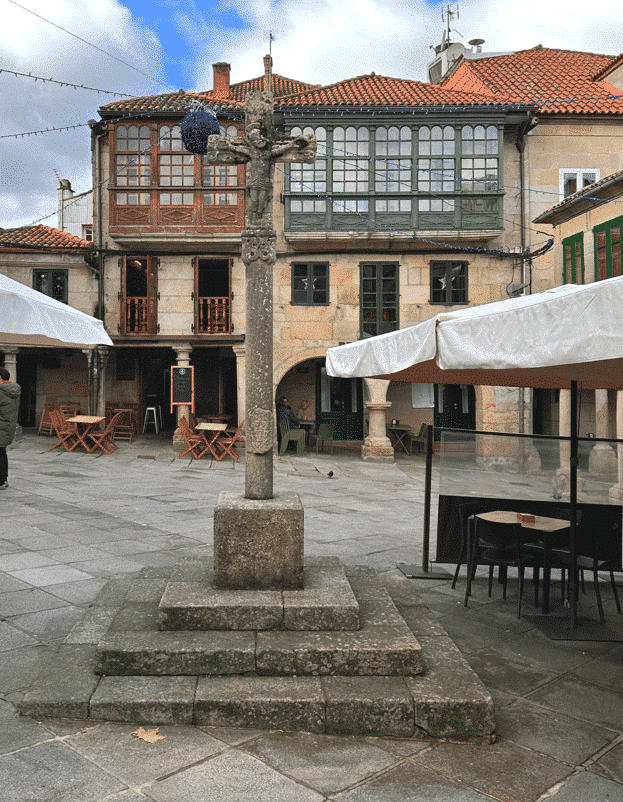Located in the heart of Galicia, Spain, Pontevedra is a city that beautifully blends history and modernity. One of its most treasured sites is Praza da Leña – an emblematic square with deep historical roots reaching back to medieval times. This article explores the rich history and cultural significance of this unique location.
A Brief Overview
Praza da Leña, which translates to “Firewood Square,” is located in the old town district of Pontevedra. Its name derives from its historic function as a marketplace where firewood was sold during medieval times. The square has been carefully preserved over centuries and now stands as a testament to the city’s past while serving as an active hub for locals and tourists alike.
Architectural Highlights
The architecture surrounding Praza da Leña offers a glimpse into different eras of Spanish history. The most notable buildings include Pazo de Castro Monteagudo and Casa das Campás.
Pazo de Castro Monteagudo dates back to the 18th century and exemplifies Baroque residential architecture common during that period. Once home to noble families, it now houses part of Pontevedra’s Museum network – Museo Provincial de Pontevedra.
Casa das Campás, on the other hand, represents traditional Galician architecture with its granite façade adorned by two coats-of-arms representing noble lineage dating back hundreds of years. Today it serves as headquarters for Vigo University’s Campus in Pontevedra.
Museo Provincial de Pontevedra
An integral part of Praza da Leña’s allure lies within Pazo de Castro Monteagudo – home to one segment (the Sixth Building)of Museo Provincial de Ponteaveda complex . This museum is a must-visit for anyone interested in Galician art, history, and culture. The collection showcases artifacts spanning from prehistoric times to the present day.
Modern Day Praza da Leña
While preserving its historical essence, Praza da Leña has evolved into an urban space that resonates with modern life. It’s a popular spot for social gatherings and cultural events such as concerts and exhibitions. Its charming atmosphere is amplified by the presence of numerous cafes and restaurants offering local cuisine – making it an ideal place to sample traditional Galician dishes while soaking up Pontevedra’s vibrant city life.
A Green Oasis
Praza da Leña also stands out for its commitment towards maintaining green spaces within urban settings. In 2010, it was transformed into a “green square” through the addition of trees, shrubs, flowers and benches designed by award-winning landscape architect Teresa Gali-Izard. This initiative not only enhanced its aesthetic appeal but also contributed to Pontevedra’s reputation as one of Spain’s most pedestrian-friendly cities.
In Conclusion
Ponteverda’s Praza da Leña offers more than just a glimpse into Spanish history; it encapsulates centuries of evolution – from medieval marketplace to noble residences; from cultural hub to contemporary meeting point; all while managing to retain its original charm and authenticity. Whether you’re drawn by the allure of historic architecture or simply looking forward to enjoying Galician hospitality amidst picturesque surroundings – Praza da Leña promises an unforgettable experience!
Frequently asked questions
What is Praza da Leña and where is it located?
Praza da Leña, also known as Wood Square, is a historic square situated in the heart of Pontevedra city in Galicia, northwest Spain. It’s one of the most emblematic squares in the old town of Pontevedra due to its history and unique charm. The square was once a bustling marketplace for wood sellers during medieval times.
What are some significant landmarks or attractions at Praza da Leña?
The main attraction at Praza da Leña is the Pazo de Castro Monteagudo, an impressive 18th-century Baroque-style mansion that currently houses the Pontevedra Museum’s Ethnography and History section. Other notable buildings surrounding the square include traditional Galician stone houses with wooden galleries. There’s also a beautiful central fountain made from granite which adds to the picturesque atmosphere of this location.
What can I do when visiting Praza da Leña?
Apart from admiring its historic architecture and relaxing by its tranquil fountain, visitors can explore numerous cafes and restaurants around Praza da Leña that offer local Galician cuisine including seafood dishes paired with Albariño wine. Additionally, you can visit nearby attractions such as Teatro Principal or Basilica Santa Maria within walking distance from this square.
Can you tell me more about its history?
Praza da Leña dates back to medieval times when it served as a crucial commercial hub for selling firewood (leña), hence earning its name ‘Wood Square.’ During this time period, many people would gather here to buy wood for heating purposes especially during winter months. Over centuries, it has witnessed various transformations but still retains much of its original character today with cobblestone streets and historic buildings around it.
What are the opening hours of Praza da Leña?
Praza da Leña is a public square, so it’s open 24 hours a day, seven days a week. However, the operating hours for businesses such as restaurants or cafes around this area may vary. It’s recommended to check their specific timings if you plan on visiting these establishments. The Pontevedra Museum located in Pazo de Castro Monteagudo also has its own working schedule which can be checked from their official website.












